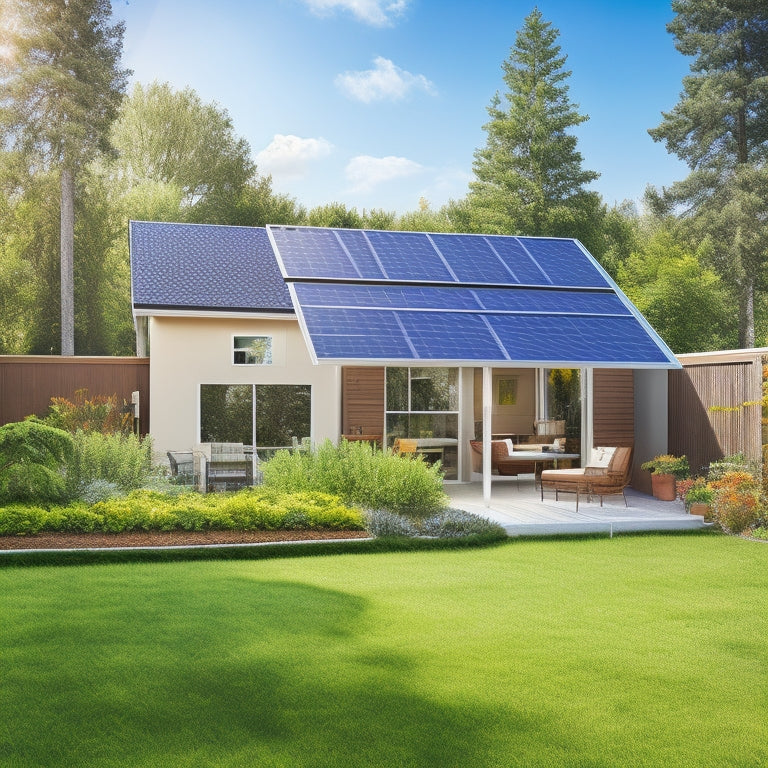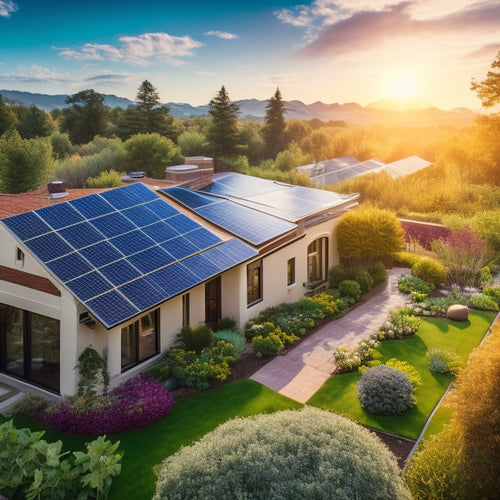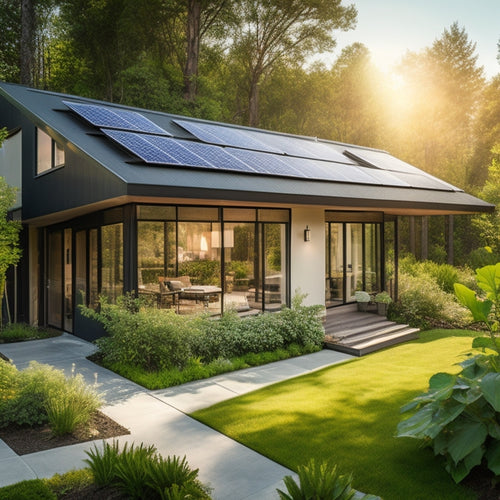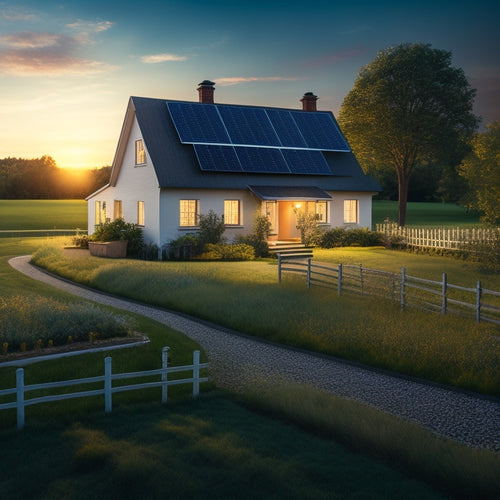
Solar Power Solutions Under $10000 and Their Prices
Share
You can choose from a variety of solar power solutions that fit your budget, with prices under $10,000. Small scale solar systems can reduce your energy bills by up to 50%, while residential solar panel kits offer easy installation with pre-assembled components. DIY solar power packages let you tailor your setup to your energy needs and roof space. Additionally, grid tie solar systems, off grid solar solutions, solar water heating systems, solar powered generators, and portable solar energy kits are also available. Each solution has its unique features, and exploring these options further will help you find the perfect fit for your energy goals.
Key Takeaways
- Small-scale solar systems under $10,000 can reduce energy bills by up to 50% and pay for themselves in 5-7 years.
- Residential solar panel kits with easy installation start at around $5,000 and include high-efficiency panels, inverters, and mounting hardware.
- DIY solar power packages offer customization options and cost between $2,000 and $8,000, depending on system design and component selection.
- Grid tie solar systems, suitable for connecting to the grid, range from $2,000 to $6,000, with string inverters being a cost-effective option.
- Off-grid solar solutions, ideal for remote areas, can cost between $3,000 and $10,000, depending on system size and component quality.
Small Scale Solar Systems
Typically, small scale solar systems are ideal for homeowners or small businesses looking to reduce their energy bills and carbon footprint.
These systems are designed to generate a moderate amount of electricity, usually between 1-10 kilowatts, making them suitable for small to medium-sized properties.
With a small scale solar system, you can expect to reduce your energy bills by up to 50% or more, depending on your energy usage and the system's solar efficiency.
The cost savings can be substantial, with some systems paying for themselves in as little as 5-7 years through reduced energy bills and potential government incentives.
When selecting a small scale solar system, consider factors such as panel quality, inverter efficiency, and installation quality to guarantee peak performance and maximum cost savings.
Residential Solar Panel Kits
You're contemplating a residential solar panel kit, which typically includes a set of pre-selected components, such as photovoltaic panels, an inverter, and mounting hardware.
You'll want to know that these kits are designed for easy installation, often with minimal tools and knowledge required.
When selecting a kit, you'll need to evaluate the space requirements, ensuring you have sufficient roof area or ground space to accommodate the system.
Kit Components Included
Your residential solar panel kit includes a carefully curated set of components designed to guarantee a seamless and efficient installation process.
These components are precision-engineered to work in harmony, ensuring maximum energy output and peak performance.
The kit includes:
- High-efficiency solar panels from reputable manufacturers, available in various solar panel types (monocrystalline, polycrystalline, or thin-film) to suit your energy needs
- A durable and weather-resistant mounting system, designed for secure and easy installation
- A state-of-the-art inverter, converting DC power from the solar panels to AC power for your home
- A sophisticated energy storage system, allowing you to store excess energy generated during the day for use during the night or on cloudy days
- An extensive monitoring system, providing real-time data on your energy production and consumption, helping you enhance your energy usage
Easy Installation Process
The installation process of your residential solar panel kit is engineered to be straightforward and hassle-free, allowing you to employ the power of solar energy in no time.
You'll find that the kit's pre-assembled components and detailed instructions make it easy to get started. The solar panels themselves are designed for maximum solar panel efficiency, guaranteeing you generate the most power possible from the sun's rays.
As you begin the installation, you'll notice that safety is a top priority. The kit includes installation safety features such as grounding points and secure fasteners to prevent electrical shock and other hazards.
You'll also appreciate the sturdy mounting system, which guarantees your solar panels are securely fastened to your roof.
Throughout the installation process, you'll find that the kit's components are carefully labeled and organized, making it easy to identify and connect the various parts.
With a few simple tools and some basic DIY skills, you'll be leveraging the power of the sun in no time.
Space Requirements Considered
They've carefully designed residential solar panel kits to accommodate a variety of rooftop spaces, guaranteeing that homeowners with limited roof area can still capture the power of solar energy.
When considering space requirements, it's crucial to evaluate the size and layout of your rooftop to determine the ideal solar panel configuration.
-
Assess your roof's size and shape to select the right solar panel kit for your needs.
-
Consider the direction and angle of your roof to maximize solar panel efficiency.
-
Evaluate the amount of shading on your roof to determine the best placement for your solar panels.
-
Calculate the required energy storage capacity based on your daily energy consumption.
-
Research local building codes and regulations to verify compliance with residential solar panel installations.
DIY Solar Power Packages
You'll find that DIY solar power packages offer various system design options, allowing you to tailor your setup to your specific energy needs and available roof space.
These packages typically include a range of kit components, such as solar panels, inverters, and mounting hardware, which you'll need to assemble and install.
Before getting started, it's crucial to understand the assembly requirements, including any necessary electrical connections and structural reinforcements.
System Design Options
Frequently, homeowners opt for DIY solar power packages to save on installation costs and gain a sense of accomplishment. When designing your system, you'll need to evaluate several factors to guarantee peak performance and system efficiency.
-
System size and configuration: Determine the number of panels and inverters required to meet your energy needs, taking into account factors like roof size, shading, and local building codes.
-
Mounting options: Choose from roof-mounted, ground-mounted, or tracking systems, each with its own benefits and drawbacks.
-
Inverter selection: Select an inverter that matches your system's voltage and current requirements, and assess features like monitoring and grid-tie functionality.
-
Energy storage integration: Decide whether to include a battery bank for energy storage and backup power, and confirm compatibility with your inverter and panel array.
-
Monitoring and control systems: Think about adding monitoring and control systems to track your energy production, consumption, and system performance in real-time.
Kit Components Included
With the system design options in place, it is vital to understand the kit components included in DIY solar power packages, as these prefabricated solutions can greatly simplify the installation process. You'll want to guarantee that your kit includes the necessary components to match your energy efficiency goals.
The following table outlines the typical components included in DIY solar power packages:
| Component | Description | Quantity |
|---|---|---|
| Solar Panels | Monocrystalline or polycrystalline solar panel types, 250-300W each | 10-15 |
| Mounting Hardware | Roof or ground mounting system, including racks and clamps | 1 set |
| Inverter | String inverter or microinverter for converting DC to AC power | 1-3 |
When selecting a DIY solar power package, consider the type and quality of solar panels included, as they directly impact energy efficiency. Additionally, confirm the mounting hardware is compatible with your roof type and the inverter is suitable for your energy output needs. By understanding the kit components included, you can make an informed decision and optimize your solar power solution.
Assembly Requirements
When it comes to DIY solar power packages, assembly requirements play a critical role in guaranteeing a successful installation. As you prepare to assemble your solar power system, it's crucial to understand the necessary steps to guarantee a safe and efficient installation.
You'll need to contemplate the following assembly requirements:
-
Mounting hardware: Verify that all necessary mounting hardware, such as clamps, brackets, and bolts, are included in your kit and compatible with your roof type.
-
Electrical connections: Confirm that all electrical connections are secure, properly sized, and meet local electrical codes.
-
Grounding and bonding: Validate that your system is properly grounded and bonded to prevent electrical shock and guarantee safe operation.
-
Panel alignment: Align your solar panels at the prime angle to maximize energy production, considering your location's latitude and climate.
-
System monitoring: Install a monitoring system to track your energy production, allowing you to identify potential issues and enhance performance.
Grid Tie Solar Systems
Grid tie solar systems connect directly to the grid, allowing you to sell excess energy back to the utility company and offset your electricity bills. This setup enables you to take advantage of grid benefits, such as net metering, which measures the difference between the electricity you produce and consume.
| Inverter Type | Price Range |
|---|---|
| String Inverter | $2,000 - $4,000 |
| Microinverter | $3,000 - $5,000 |
| Power Optimizer | $2,500 - $4,500 |
| Hybrid Inverter | $3,500 - $6,000 |
| DC-DC Converter | $1,500 - $3,000 |
When selecting a grid tie system, you'll need to evaluate the type of inverter that best suits your needs. String inverters are a cost-effective option, while microinverters provide more flexibility and monitoring capabilities. Power optimizers offer a balance between the two, and hybrid inverters allow for battery integration. DC-DC converters are ideal for small-scale systems. Prices vary depending on the inverter type, system size, and installation costs. With a grid tie system, you can maximize your energy production and reduce your reliance on the grid.
Off Grid Solar Solutions
Off-grid solar solutions, also known as standalone power systems, operate independently of the grid, providing electricity to remote areas or locations where traditional power infrastructure is unavailable.
These systems are ideal for cabins, rural homes, or areas with unreliable grid connections. As you consider off-grid solar solutions, you'll need to assess your energy requirements and choose the right components for your system.
Some key considerations include:
-
System size and design: You'll need to determine the size of your solar array and the capacity of your solar battery storage to guarantee you have enough power to meet your energy needs.
-
Battery selection: Choose deep cycle batteries designed for off-grid systems, and consider the depth of discharge, cycle life, and maintenance requirements.
-
Charge controllers and inverters: Select high-efficiency charge controllers and inverters that can handle the surge capacity of your system.
-
Mounting and installation: Verify your system is securely mounted and installed to withstand environmental factors like wind and snow loads.
-
Renewable energy incentives: Research local and national incentives that can help offset the cost of your off-grid solar solution.
Solar Water Heating Systems
By leveraging the sun's energy to heat water, you can considerably reduce your reliance on traditional energy sources and lower your utility bills.
Solar water heating systems are a cost-effective way to utilize the sun's energy, providing a high solar thermal efficiency of up to 80%. This means you can enjoy hot water while reducing your energy consumption.
These systems typically consist of solar collectors, a storage tank, and a piping system. The solar collectors absorb the sun's energy, heating the water in the storage tank.
You can then use this hot water for various purposes, such as washing dishes, taking a shower, or doing laundry.
Solar Powered Generators
Several solar powered generators on the market can provide you with a reliable source of energy, especially during power outages or when you're away from the grid.
These generators use solar panels to charge a battery, which can then power your devices and appliances. With high-efficiency solar panels, you can maximize your energy output and reduce your reliance on traditional fossil fuels.
Some key features to evaluate when selecting a solar powered generator include:
-
Capacity: Choose a generator with a battery capacity that meets your energy needs, ranging from 500 Wh to 2000 Wh.
-
Solar panel efficiency: Look for generators with high-efficiency solar panels (above 20%) to maximize your energy output.
-
Charging speed: Evaluate generators with fast charging speeds, which can recharge your battery in as little as 2 hours.
-
Portability: Select a generator that's lightweight and compact, making it easy to take on the go.
-
Incentives: Take advantage of renewable energy incentives, such as tax credits and rebates, to offset the cost of your solar powered generator.
Portable Solar Energy Kits
This portable solar energy kit lets you harness the sun's power wherever you go, providing a reliable and eco-friendly energy solution for your devices and small appliances.
You can charge your gadgets on-the-go with a solar charging station that's compact and lightweight. These kits usually come with a foldable solar panel, a portable battery pack, and a DC-AC inverter.
The solar panel absorbs sunlight and stores the energy in the battery pack, which can be used to power your devices later. You can expect an output of 100-200 watts, sufficient to charge laptops, smartphones, and small appliances.
Look for kits with high-efficiency solar panels and deep cycle batteries for peak performance. Prices vary depending on the capacity and features, but you can find a decent portable solar energy kit for under $1,000.
Some popular options include the Goal Zero Nomad 7, the Anker PowerPort Solar Lite, and the Suaoki 60W Solar Charger.
Frequently Asked Questions
Can I Install Solar Panels on a Rented Property?
When considering solar panels on a rented property, you'll need to weigh rented property considerations, such as lease terms and landlord approval, against solar panel options like portable systems or community solar programs that offer flexibility.
Do Solar Panels Work During Power Outages?
When you invest in solar panels with battery storage, you'll achieve grid independence, ensuring you have power during outages. Your system will continue to generate electricity, storing excess in batteries for later use, keeping you powered up even when the grid goes down.
Are Solar Panels Resistant to Extreme Weather Conditions?
You'll be storm-ready with solar panels, whose durability is forged like steel in the fire of extreme weather performance, withstanding torrential rains, scorching heat, and hurricane-force winds, ensuring your power stays on when the grid goes dark.
Can I Use Solar Power for My RV or Boat?
You can utilize the sun's energy for your RV or boat with RV solar or boat solar systems, respectively, which typically include solar panels, charge controllers, and batteries to provide reliable off-grid power for your excursions.
Do Solar Panels Increase My Property's Value?
When you 'put your money where your mouth is' by investing in solar panels, you'll reap the benefits of increased property value, as a property appraisal will likely reflect the added energy efficiency, making your home more attractive to potential buyers.
Conclusion
As you weigh your solar power options under $10,000, remember: "A bird in the hand is worth two in the bush." With the plethora of solutions outlined above, you can seize the opportunity to utilize the sun's energy and reduce your reliance on the grid. From small-scale systems to portable kits, there's a solar power solution customized to your needs and budget. Don't wait; take the first step towards a sustainable future today.
Related Posts
-

Sustainable Solar Energy for Cost-Effective Living
Adopting sustainable solar energy isn't just eco-friendly; it's a smart financial strategy. You'll slash your monthly...
-

Integrating Solar Panels Into Home Design
Integrating solar panels into your home design greatly enhances energy efficiency and lowers utility bills while addi...
-

Cost-Effective Solar Solutions for Rural Homes
Cost-effective solar solutions can alter your rural home by enhancing energy independence and slashing utility bills....


